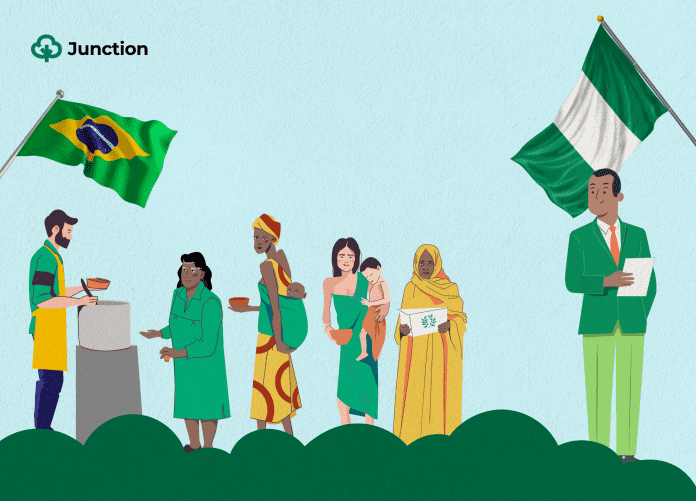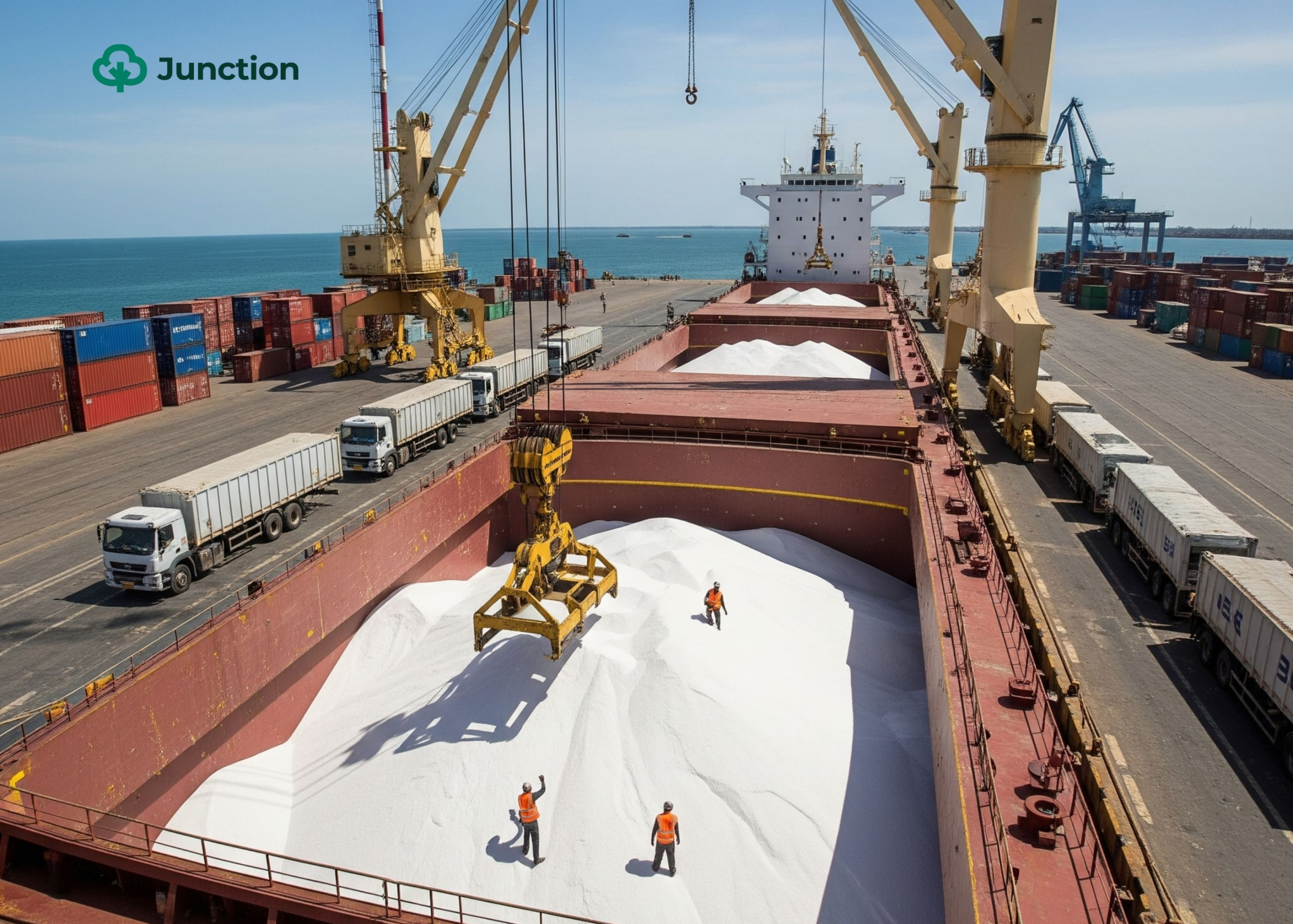Questions answere in this article:
-Â How did Brazil improve its food security situation and lift tens of millions out of hunger within a decade?
– What specific interventions can Nigeria copy from Brazil to lift millions out of hunger and reduce its food insecurity?
Nigeriaâs economy is growing but it faces significant challenges relating to food insecurity. According to the World Bank, as of August 2023, the country had the second highest number of people facing acute food insecurity at 24.9 million. It is second only to the Republic of Congo â a country riddled with war for over 25 years. This is a serious problem that needs to be addressed.
Nigeria can take a page from Brazilâs book to dig themselves out of the food insecurity bubble due to their similar population and climate conditions.
The table below shows that Nigeria has a population of over 218 million people, only about 3 million more than Brazil, which has a population of over 215 million. However, Brazil has a much larger land area than Nigeria; therefore, it can be hypothesised that if practices applied to a larger land area can be applied to a smaller area, they should be more effective and even show results within a shorter period.Â

Also, Brazil is a good role model because, pre-2019, it managed to reduce the number of its undernourished populace by more than 80% in 10 years. This article explores the methods in which the country was able to achieve this and measures to prevent relapse into food insecurity, as seen in Brazil as of 2022.
Brazil has made significant progress in reducing food insecurity in recent decades. The Zero Hunger program, launched in 2003 to eliminate hunger and poverty in the country, successfully reduce hunger by over 50% and poverty by over 70%. The policy approaches were based on protection against various types of vulnerability, expansion of family incomes, food security promotion, and human capital development.
Hunger is a multi-sectoral problem requiring an integrated, cross-government response and as such, the Zero Hunger programme recognizes that poverty reduction, food security and support for small scale agriculture are intimately connected. Its interlinked initiatives aimed to increase access to food for the poorest people and support production from small scale and family farmers. Increasing access to food could be done through cash transfers, livelihoods support and targeted free meals.
Thus, the main policy pillars are highlighted in this article - the Bolsa Familia, Alimentação Escolar (school meal) programme, Fortalecimento da Agricultura Familiar (strengthening family agriculture), The Programa de Aquisição de Alimentos da Agricultura Familiar (PAA) (Family Agriculture Food Procurement Programme).
These programs would lead to a reduction in the population’s food insecurity percentage from 7.9% to 2.5% over ten years, from the implementation in 2003 to 2013. It entailed phased adjustment from the anti-policy policies present at the time, shifting the focus of the policy intervention and setting up new policy options and tools.

A comprehensive food security strategy which addresses all aspects of food security including production, access, utilisation and continuation is needed.
Current strategies in Nigeria include the Anchor Borrowers Programme (ABP), launched in 2015 to provide loans to farmers at a subsidised interest rate, the Presidential Fertiliser Initiative (PFI), launched in 2016 to enable farmers to access affordable fertiliser, the National Social Safety Net Coordinating Office (NASSCO), which was established in 2012 to coordinate the government’s social safety net programs and the Nigerian Agricultural Insurance Corporation, which provides insurance to farmers against crop losses.
Between the launch years of 2012 and 2016, the percentage of people in food insecurity did not decrease, instead, it increased from 9.1% to 9.4% in 2016. Also, from 2019 to 2021, the share of Nigerians facing severe food insecurity rose to 21.3% from 19.1%.
Hence, a better approcach to solving this problem is important.
Restructuring financial support
As part of the Zero hunger initiative, the Bolsa Familia cash transfer programme provided direct income under particular conditions to 12.7 million families (nearly 50 million people) facing poverty and deprivation through linking and integration with other social programmes. Access to financial benefits is based on access to basic rights such as health, education, and food in order to support poverty reduction more effectively.
Providing financial support to farmers can lead to increase in agricultural production. This is evidential in ‘Impact of Agricultural Financing on Agricultural Output, Economic Growth and Poverty Alleviation in Nigeria,’ where a researcher showed that the support provided by Commercial Banks and the Agricultural Credit Guarantee Scheme Fund to Nigeria’s agricultural sector had a significant impact on the sector’s contribution to the country’s economic output, reducing poverty and promoting economic growth. The study also found a long-term connection among these factors in Nigeria. Based on these findings, the researcher suggests that the Central Bank of Nigeria (CBN) should lower the cash-reserve ratio, with the funds generated from this adjustment directed towards agricultural credit initiatives.Â

Brazil provides financial support to farmers in the form of subsidies and loans. This helps farmers to invest in new technologies and improve their production methods. Nigeria can provide similar financial support to farmers to help them improve their productivity. Although the ABP still exists, improving the current policy would go a long way. So far, it has been criticised for its lack of transparency and accountability.
To mitigate this, the government should establish a more transparent and accountable loan application process, publishing a clear eligibility criterion and making it more accessible to all farmers. It is also essential that the implementation of the loan program is monitored seamlessly to track and investigate any issues that occur. The government should work with commercial banks to reduce the interest rates on agricultural loans. This would make it easier for farmers to repay their loans and invest in their businesses. There should also be subsidies on inputs such as fertilisers and seeds.Â
Agricultural research and development
In âthe payoff to Agricultural Researchâ Pardey shows that even a 1% increase in public research and development knowledge is likely to lead to a 0.15% increase in agricultural productivity.
Brazil invested heavily in agricultural research and development, which has helped to increase crop yields and improve agricultural productivity, with a focus on developing new technologies and practices to increase crop yields and improve food security. For example, development of new crop varieties that are resistant to pests and diseases, more resistant to drought and other stresses and higher yielding than traditional varieties.
Researchers at the Brazilian Agricultural Research Corporation (Embrapa) have developed a new type of soybean that is resistant to a major soybean pest, the Asian soybean rust. This new variety has helped to reduce soybean losses to the rust by up to 80%, saving farmers billions of dollars each year. Also, in improvement of agricultural practices, researchers at Embrapa developed a no-tillage farming systems that helps to reduce soil erosion and improve water retention. This system has been adopted by millions of farmers in Brazil and other countries and has helped increase crop yields by up to 30%.
Also, to aid farmers improve their productivity and efficiency, researchers at Embrapa developed a remote sensing system that can be used to monitor crop health and identify areas that need irrigation or other interventions. This system has helped farmers to reduce their use of water and fertilisers, and it has also helped to improve crop yields.Â
Brazil’s investment in agricultural research paid off as the country became a world leader in agricultural production, and was able to produce enough food to feed its own population and export to other countries. Brazil’s agricultural research has also helped to improve the livelihoods of millions of farmers and rural communities. It helped to reduce poverty and hunger in the country. Between 2002 and 2013, the number of Brazilians living in extreme poverty fell by 73%, and the number of Brazilians who were going hungry fell by 52%. Nigeria can invest in similar research and development initiatives to improve its own agricultural productivity.
Improved access to markets
Brazil has a good network of roads and railways that help to transport agricultural products from farms to markets. The table below shows the transport contribution to GDP for Nigeria and Brazil, it shows that Brazil’s transport sector is significantly larger and contributes more to the economy than Nigeria’s transport sector. In Q1 2023, Brazil’s transport sector contributed $1,660,139.93 million to GDP, while Nigeria’s transport sector contributed $406.14 million. This trend continued in Q2 2023, with Brazil’s transport sector contributing $1,664,983.13 million to GDP, while Nigeria’s transport sector contributed $304.81 million.
There are a number of factors that contribute to this difference. Brazil has a larger economy than Nigeria, and it also has a more developed transportation network. Brazil has a vast network of roads, railways, and airports, while Nigeria’s transportation network is underdeveloped, with many roads in poor condition and a lack of railways and airports. Additionally, the Brazilian government is investing heavily in infrastructure development, while the Nigerian government has been slower to invest in infrastructure.

It is evident that Brazil’s transport sector is more efficient and productive than Nigeria’s transport sector. For example, the South American giant earned about $12.45 billion in GDP from the trasnport sector in the first quarter of 2023 while Nigeria earned just a little over $1 billion in the same period.Â
With an efficient transport network, Brazillians can move goods, people and services more cheaply and easily, which benefits the economy as a whole.
Nigeria should consider creating a government marketing agency to aid farmers in marketing their products domestically and eventually internationally. Training could also be provided to farmers on marketing and negotiation skills as well as sustainable agricultural practices. Financial incentives could also be provided to farmers who adopt sustainable agricultural practices, in doing so these practices can be feasible long term.
Ofcourse, there will be no benefit to the above if Nigeria doesnât invest in improving its transportation networks to make it easier and cheaper for farmers to get their products to market. Post harvest loss rates are up to 60% for perishable crops, Nigeria needs to rapidly introduce new storage solutions across its agricultural system; in combination with transport facilities â this will reduce post-harvest losses.
The Fortalecimento da Agricultura Familiar (strengthening family agriculture) pillar intended to strengthen and stimulate small-scale and family-based agriculture for increase in quality and quantity of the food supply to support increased incomes for rural households. This programme includes subsidised credit, training and technical assistance, and insurance for small-scale and family farmers.
The Programa de Aquisição de Alimentos da Agricultura Familiar (PAA) (Family Agriculture Food Procurement Programme) ensured a stable market price for products from small-scale farmers, for example by buying local food products for government feeding programmes or for local food bank.
Agricultural research and development and improved rural infrastructure go hand-in-hand with the aforementioned policy modifications. These investments will help foster a more supportive environment for agricultural production and marketing. By implementing these policy changes, the Nigerian government can help to ensure that farmers have access to the loans they need to invest in their businesses and increase agricultural production. This would help to reduce food insecurity and poverty in Nigeria.
A compounding effect of tweaking the already existing system to increase productivity, inclusion and transparency will ensure that the food security strategy in Nigeria addresses eradicating extreme poverty and hunger a cornerstone of its social and economic policies.Â
Recent Setback and ongoing challenges in Brazil’s battle against hunger
Whilst the Zero Hunger programme, amongst others, was a significant driver in removing Brazil from 20 years of being on the World Hunger map, it is important to note that as of 2022, Brazil has returned to the UN Hunger Map.
A survey by the FAO revealed that 61 million Brazilians live in some type of food insecurity, and more than 15.5 % (33.1 million people) face severe food insecurity. As of 2023, the South American country faces a setback which resembles the situation in the 1990s.
This setback can be attributed to the government’s failure to adopt a series of critical social protection policies and safety nets, which were implemented previously. Instead policies like the Bolsa Familia amongst others had funding cut by up to 25%. These weakened in the following years, coupled with the poor public management of the Covid-19 pandemic.
Thus, it is paramount that Nigeria maintains the policies and systems put in place and that it is continued even after a new government comes into power.Â
For example, Tinubu has declared a state of emergency on food insecurity and allocated â¦200 billion (nearly 10%) of his administration’s supplementary budget to the Federal Ministry of Agriculture and Food Security. Without a robust return to government social spending, there will be little chance of stopping hunger, and as José Graziano da Silva, the former Director-General of the FAO once said, ‘the cost of hunger is much greater than the investment needed to avoid it’.



